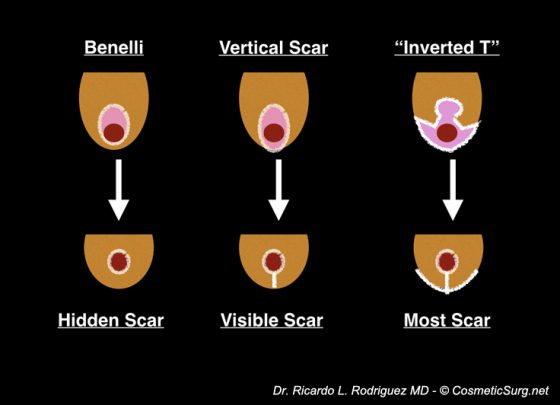In plastic surgery, scars are always a concern and a good surgeon will discuss all of your options, including what types of scars are likely to result from any surgical plan. Years ago I wrote about the various surgical techniques related to breast procedures. Today I’d like to concentrate on the Breast lift, specifically, and the types of scars associated with Breast lifts.
For women who are wanting a breast lift, scars are always one of the main concerns, so I’m going to answer this common question here.
What type of scar will I get with a breast lift procedure?
Any procedure that lifts the breast will require the surgeon to make an incision and that incision will leave a scar on your breast. In most cases, the scar will eventually fade and the positive aesthetic outcome of the ‘lifted’ breast will far surpass the remnants of a scar. But the fact is, you will have a scar following a breast lift (whether or not an implant is involved in the procedure). In fact, breast lifting actually occurs in breast reductions, too.
Surgical technique determines scar shape
Any procedure that lifts the breast will require the surgeon to make incisions to change the breast shape so that the breast is lifted. There are three different surgical approaches that can theoretically be performed for procedures that lift the breast:
- Benelli scar
- Vertical scar
- Inverted T (Wise pattern)

The figure below describes the incision pattern and what the scars look like after completion of surgery. Each surgical technique will leave you with a distinct type of scar.
In the top row, the white lines are the skin incision pattern, or the cut out pattern of how your surgeon will excise the skin. The pink is the area of the actual skin and tissue that he removes during surgery.
As you can see in the diagram, the Benelli pattern takes out the least amount of skin, and the Inverted T (Wise-pattern) takes out the most skin. The bottom row illustrates what the scars will most likely look like after surgery. To summarize:
- Benelli scar is around the areola, forming the border of the areola
- Vertical scar is visible in the middle underside of the breast
- Inverted T (Wise-pattern) has two scars, a vertical and a horizontal
Which scar looks the best?
If you are looking for the best looking scar, or the smallest scar, that would be the Benelli. This is eventually a ‘hidden scar’ as it will eventually fade into the nipple line. Most patients are also happy with the vertical scar as the scar is on the underside of the breast, and not exposed horizontally on the chest wall. In my opinion, the least attractive scar is the Inverted T technique (Wise pattern), which is really two scars.
Complication rates scars
The most commonly used incision pattern in the U.S. is the Inverted T, also known as the Wise pattern or Anchor pattern. For the most part this is simply because the Wise pattern has been in existence for many decades while the other techniques are younger and, therefore, not as widely adopted.
Recently I read an article on Medscape from the journal “Wounds” about wound healing problems in Breast reduction and Breast lift (Mastopexy). The article, Treatment of wounds following breast reduction and mastopexy with subsequent wound dehiscence with charged polystyrene microspheres, cited that the use of the Inverted T technique (Wise pattern) has a 10% wound complication rate. IMO, that is a pretty high complication rate, and it is much higher than the other two techniques, the Vertical scar and the Benelli technique. In my practice, the wound rate with the other scars is less than 5%.
Inverted T (Wise pattern) scar
Because of the large pattern of skin cutout with the Inverted T scar (Wise-pattern) the scar complication can look really bad. Here is a photo of one of these wounds using this surgical technique. Although it is not a life threatening problem, this wound complication at the incision location could certainly look very scary to the patient. In addition to scars, this procedure also tends to flatten the breast, instead of making them perky. I no longer perform this technique in my practice as I feel that the other surgical techniques are far superior.

As shown in the figure above (Source: Wounds, HMP communications, as seen in Medscape), this pattern cuts out the most skin and leaves the most scarring. The wound breakdown is usually where the vertical and horizontal scars underneath the breast come together. The photograph is worth a thousand words.
Vertical scar (aka Lassus technique)
Less common is the Vertical scar technique, which has less scarring than the Wise pattern, but has a vertical scar visible in the middle underside of the breast. The vertical scar has the advantage that it can give the breast a better shape and the scar does eventually fade with time. I use this technique primarily for breast lifts and breast reductions of any size.
For breast lift with implants, the implant itself gives such great shape to the breast, that the Benelli is truly the best choice of technique . The vertical scar can have wound complications, but because the scar area is so much smaller than the Inverted T scar (Wise pattern), the complications are much easier to manage.
Benelli scar
Very few surgeons use the Benelli scar because it is technically more difficult. I like it because the scar is well camouflaged as it forms the border of the areola. The only downside with this type of scar is that it can not be used in large Breast reductions. However, it is ideal for small Breast reductions, Breast lifts, and Breast lift with implants.
Most importantly, in cases of breast lifts with implants, there are hardly any wound complications with this technique. There’s a good reason for this. When you add an implant to a Breast lift, you are filling up the skin envelope and, as a result, you do not need to take out much skin at all. You really only need to take out enough skin to move the areola to the new position higher up. The procedure is safer, and has less scars. That’s why the Benelli is my favorite.
Please remember, all patients should discuss what types of outcomes they can expect, including scar expectations, with with their plastic surgeon prior to having breast lift surgery. Knowing ahead of time where your scars will be placed and what they will look like is just as important as knowing what kind of results you can expect from any plastic surgery.



